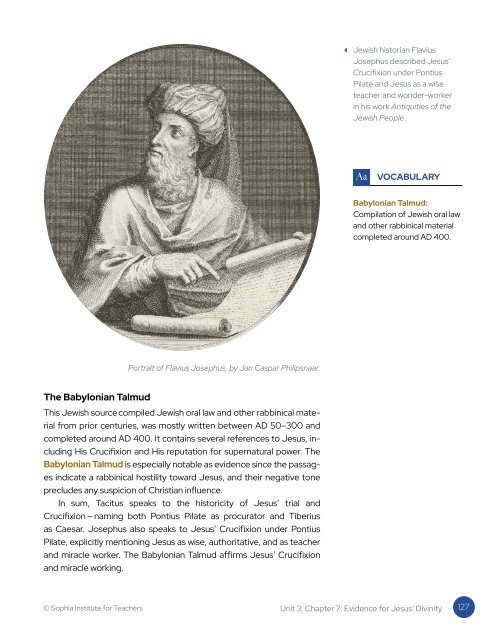CFS-WB-CH07
You also want an ePaper? Increase the reach of your titles
YUMPU automatically turns print PDFs into web optimized ePapers that Google loves.
Jewish historian Flavius<br />
Josephus described Jesus’<br />
Crucifixion under Pontius<br />
Pilate and Jesus as a wise<br />
teacher and wonder-worker<br />
in his work Antiquities of the<br />
Jewish People.<br />
Aa<br />
VOCABULARY<br />
Babylonian Talmud:<br />
Compilation of Jewish oral law<br />
and other rabbinical material<br />
completed around AD 400.<br />
Portrait of Flavius Josephus, by Jan Caspar Philipsnaar.<br />
The Babylonian Talmud<br />
This Jewish source compiled Jewish oral law and other rabbinical material<br />
from prior centuries, was mostly written between AD 50–300 and<br />
completed around AD 400. It contains several references to Jesus, including<br />
His Crucifixion and His reputation for supernatural power. The<br />
Babylonian Talmud is especially notable as evidence since the passages<br />
indicate a rabbinical hostility toward Jesus, and their negative tone<br />
precludes any suspicion of Christian influence.<br />
In sum, Tacitus speaks to the historicity of Jesus’ trial and<br />
Crucifixion — naming both Pontius Pilate as procurator and Tiberius<br />
as Caesar. Josephus also speaks to Jesus’ Crucifixion under Pontius<br />
Pilate, explicitly mentioning Jesus as wise, authoritative, and as teacher<br />
and miracle worker. The Babylonian Talmud affirms Jesus’ Crucifixion<br />
and miracle working.<br />
© Sophia Institute for Teachers<br />
Unit 3, Chapter 7: Evidence for Jesus’ Divinity<br />
127


